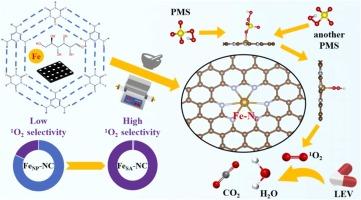The cascading anchoring strategy fabrication of high-coordination single-atom catalyst: Efficient peroxymonosulfate activation with high 1O2 selectivity
IF 11.3
1区 环境科学与生态学
Q1 ENGINEERING, ENVIRONMENTAL
引用次数: 0
Abstract
Single-atom catalysts hold great promise for peroxymonosulfate (PMS)-activated non-radical pathways, yet achieving high singlet oxygen (1O2) selectivity remains a significant challenge. In this work, we developed a six-coordinated Fe-N6 single-atom catalyst via a cascading anchoring strategy, enabling efficient PMS activation. Remarkably, this catalyst achieves 99.18% 1O2 generation selectivity and demonstrates outstanding degradation performance for levofloxacin (LEV) with a reaction rate constant of 1.475 min-1. Experimental and theoretical analyses reveal that the isolated Fe sites enhance the adsorption selectivity of terminal oxygen atoms of PMS, creating an optimal platform for generating metastable Fe intermediates. The highly oxidized metal centers of Fe act as electron acceptors to receive electrons from adsorbed PMS, thereby producing highly reactive 1O2 for rapid LEV oxidation. This work elucidates the crucial role of Fe-N6 coordination in dictating PMS activation pathways, offering mechanistic insights for designing catalysts with high selective 1O2 generation.

级联锚定策略制备高配位单原子催化剂:高氧选择性的高效过氧单硫酸盐活化
单原子催化剂在过氧单硫酸盐(PMS)激活的非自由基途径中具有很大的前景,但实现高单线态氧(1O2)选择性仍然是一个重大挑战。在这项工作中,我们通过级联锚定策略开发了一种六配位的Fe-N6单原子催化剂,实现了高效的PMS激活。值得注意的是,该催化剂的10o2生成选择性达到99.18%,对左氧氟沙星(LEV)具有良好的降解性能,反应速率常数为1.475 min-1。实验和理论分析表明,分离的铁位点提高了PMS末端氧原子的吸附选择性,为生成亚稳铁中间体创造了最佳平台。铁的高度氧化的金属中心充当电子受体,接收来自吸附的PMS的电子,从而产生高活性的1O2,用于LEV的快速氧化。这项工作阐明了Fe-N6配位在决定PMS活化途径中的关键作用,为设计高选择性生成1O2的催化剂提供了机制见解。
本文章由计算机程序翻译,如有差异,请以英文原文为准。
求助全文
约1分钟内获得全文
求助全文
来源期刊

Journal of Hazardous Materials
工程技术-工程:环境
CiteScore
25.40
自引率
5.90%
发文量
3059
审稿时长
58 days
期刊介绍:
The Journal of Hazardous Materials serves as a global platform for promoting cutting-edge research in the field of Environmental Science and Engineering. Our publication features a wide range of articles, including full-length research papers, review articles, and perspectives, with the aim of enhancing our understanding of the dangers and risks associated with various materials concerning public health and the environment. It is important to note that the term "environmental contaminants" refers specifically to substances that pose hazardous effects through contamination, while excluding those that do not have such impacts on the environment or human health. Moreover, we emphasize the distinction between wastes and hazardous materials in order to provide further clarity on the scope of the journal. We have a keen interest in exploring specific compounds and microbial agents that have adverse effects on the environment.
 求助内容:
求助内容: 应助结果提醒方式:
应助结果提醒方式:


